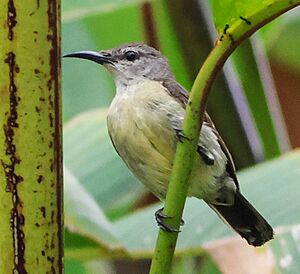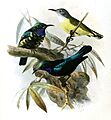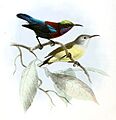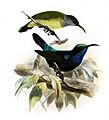Black sunbird facts for kids
Quick facts for kids Black sunbird |
|
|---|---|
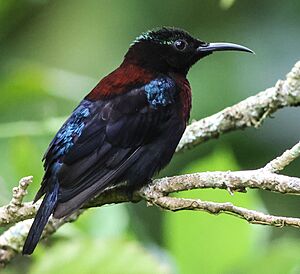 |
|
| A black sunbird male at Gardenia in Tomohon, North Sulawesi | |
| Conservation status | |
| Scientific classification | |
| Genus: |
Leptocoma
|
| Species: |
aspasia
|
| Synonyms | |
|
Leptocoma sericea |
|
The black sunbird (Leptocoma aspasia) is a small, colorful bird found in places like eastern Indonesia and New Guinea. It's part of the sunbird family, known for their bright feathers and long, curved beaks. These birds love living in warm, wet forests and even in gardens. They are often seen in subtropical or tropical moist lowland forests and mangrove forests.
Contents
About the Black Sunbird
This little songbird has a long, curved beak, perfect for sipping nectar from flowers. Black sunbirds usually live for about 3.6 years. Their colors are very different between males and females.
Male Black Sunbirds
The male black sunbird is mostly a deep, shiny black. It has a cool, shimmery blue-purple stripe across its upper chest. Its head has a bright, shining green crown. The wings and tail also have a glossy blue look. In some areas, their throat is a sparkly reddish-purple. But if you go further north, like to the Moluccas, the throat might have a bluish sparkle instead.
Female Black Sunbirds
Female black sunbirds look quite different from the males. Their chest and body are a dusty greenish-yellow color. Their wings and head are a soft brown. In northern areas, the females might look a bit plainer. They can have a dark gray head with an olive-green upper body and a yellow belly.
Young Black Sunbirds
Young black sunbirds, called juveniles, look a lot like the female sunbirds. They often have a more noticeable yellow throat.
Where Black Sunbirds Live
Black sunbirds live in different kinds of forests. They especially like the edges of forests where there's a mix of trees and open spaces. You can also find them in places where people grow coconuts or other plants. They are quite common in gardens and areas with shrubs too.
What Black Sunbirds Eat
These birds are busy eaters! They look for all sorts of arthropods, which are like insects and spiders. They also enjoy eating fruit and sipping sweet nectar from flowers and trees.
They usually look for food alone, in pairs, or with their family. Sometimes, you might see them in bigger groups. They are very active while they search for food. Black sunbirds often catch their food by "gleaning." This means they pick insects off leaves and branches. They also "hover-glean," which is when they hover in the air to catch food.
Black Sunbird Songs and Sounds
The black sunbird has a quick and sweet song. It usually lasts between 1.5 and 4 seconds. Their song can have single or many high-pitched, whistling notes. They also make quick double notes, where one is higher than the other. You might hear a clear, hollow "peep" sound. They also have a fast, shrill "zi-zi-zi-zi" sound that ends with a "pit-pit-pit" flight call.
Black Sunbird Breeding
Black sunbirds have been seen laying eggs in August and September in Sulawesi. On the islands of Papua New Guinea, they have been recorded laying eggs in March and from May to January.
Gallery
Different Kinds of Black Sunbirds
Scientists have found that there are many different types of black sunbirds. These are called subspecies. They live in various islands and regions across eastern Indonesia and New Guinea. For example, some are found in the Talaud Islands, others in Sulawesi, and many more across the Moluccas and New Guinea. Each subspecies might have slight differences in their looks or where they live.



